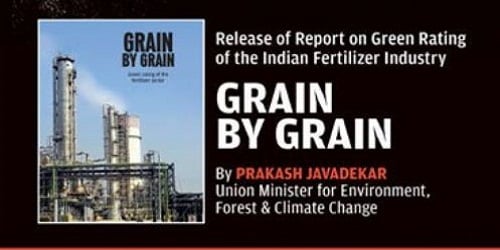On July 29, 2019, Minister for Environment and Forests Prakash Javadekar released a report titled “Grain by Grain” for the year 2019 in New Delhi. It is a Green Rating Project (GRP) on the Indian fertilizer industry conducted by the Centre for Science and Environment (CSE). GRP is a unique programme that rates the Indian industry for its environmental performance. It is regarded as India’s only independent, rigorous and credible programme of its kind. Key Points:
Key Points:
- Edition: Grain by Grain is the 7th rating project undertaken by GRP, prior being the pulp and paper, automobile, chlor-alkali, cement, iron and steel and thermal power sectors.
- Parameters: The fertilizer sector was rated on more than 50 parameters.
- Coverage: The rating covered all the 28 operational plants in the country. 57% of the plants voluntarily participated in the rating by disclosing information and by allowing GRP team to verify them on the site. The remaining plants were rated on the basis of information available in the public domain and stakeholder surveys. The biggest public sector companies- National Fertilizers Limited (NFL) and Indian Farmers Fertilizer Cooperative (IFFCO) refused to voluntarily participate in the rating.
Findings of the Report:
- Four Leaves Award: Grasim Industries Ltd’s Indo Gulf Fertilisers unit at Jagdishpur, Uttar Pradesh emerged as the top rated plant with 61% score. It received the coveted Four Leaves award for its superior performance in energy use and Green House Gas (GHG) emissions, good EHS (environment, health and safety) measures, and social responsibility, and for its transparency in sharing information.
- Three Leaves Award: The next three winners received the Three Leaves award. They were Hazira (Gujarat) unit of Krishak Bharati Cooperative Ltd (KRIBHCO), the Panambur (Karnataka) unit of Mangalore Chemicals & Fertilizers Ltd, and the Babrala (Uttar Pradesh) unit of Yara Fertilizers India Pvt Ltd.
- Improvements: Fertilizer industry performed well in curtailing its energy use and GHG emissions. Some of the Indian companies matched the global best levels.
- Cause of concern: Water use, water pollution and plant safety was a cause for concern.
- Environmental Challenge: Imbalance in the nitrogen cycle and climate change were the 2 main environmental challenges. Nitrogen use efficiency was 35% for lowland rice and under 50% for upland crops.
- Way ahead: India is the second largest producer, importer and consumer of fertilizers (mainly urea). With nitrogen pollution reaching alarming levels, the industry needs to rethink the way it produces and sells fertilizers.
About CSE:
♦ Headquarters: New Delhi
♦ Director General: Sunita Narain
AffairsCloud Recommends Oliveboard Mock Test
AffairsCloud Ebook - Support Us to Grow
Govt Jobs by Category
Bank Jobs Notification




